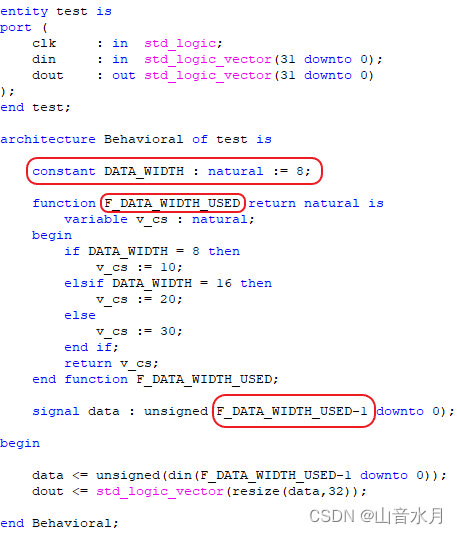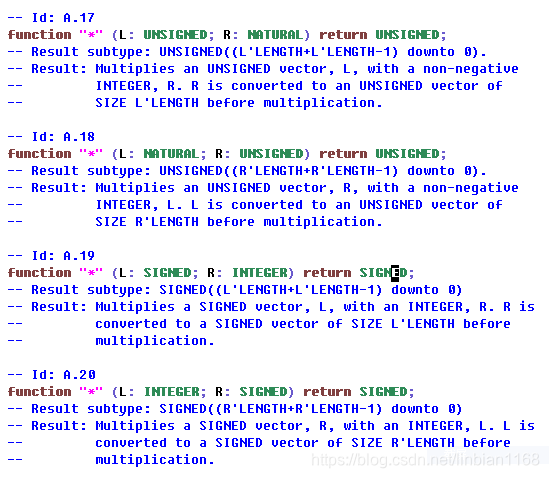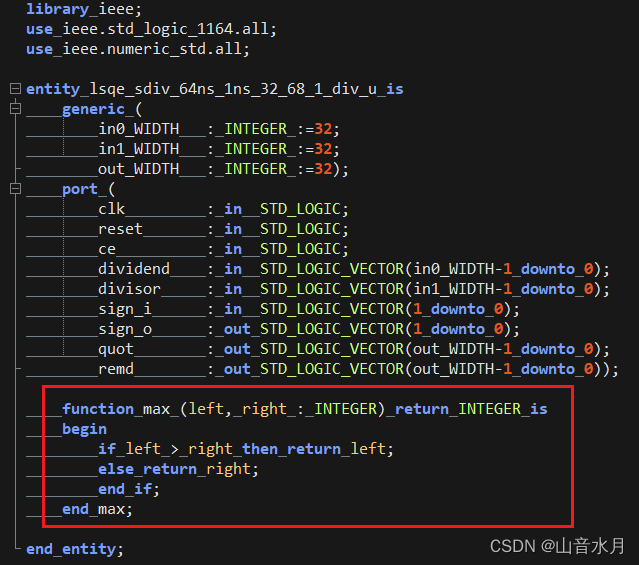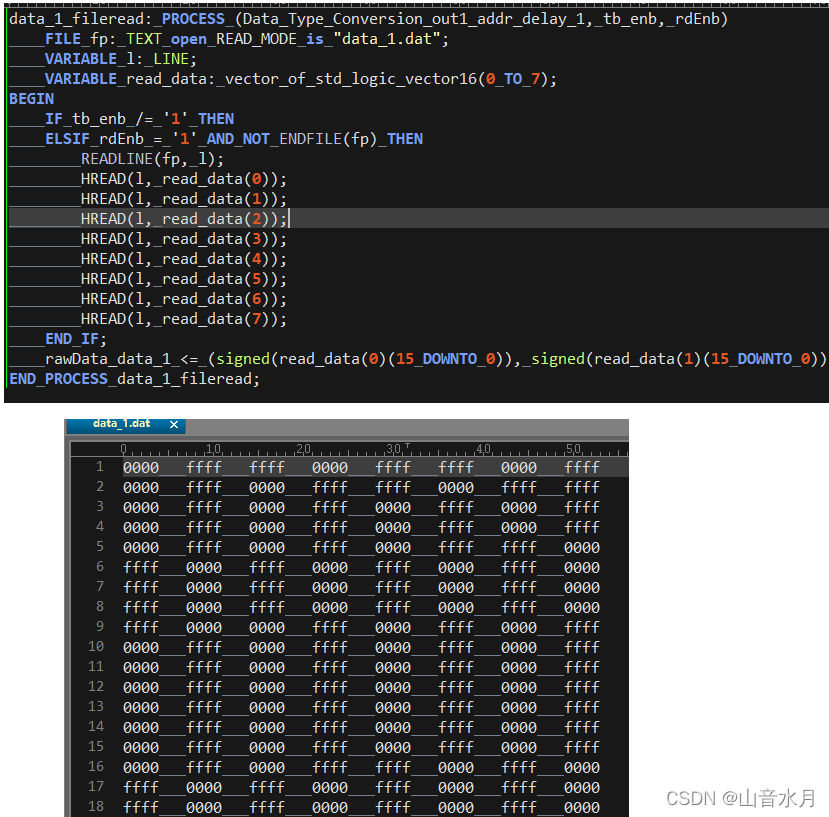文章目录
使用function名称作为“常量”
测试代码如下,function仅有名称,没有输入,在function内部使用全局constant进行参数处理,后续代码中可以直接使用function名称作为常量

numeric_std包集中使用乘法的注意项
近日看到一个VHDL Coding Style中提示说,使用numeric_std包集时,不要直接将unsigned/signed数据与natural/integer类型的数据相乘。
今天看了一下numeric_std的源码发现,如果直接直接将无符号数/有符号数与整数相乘的话,乘积很有可能会溢出。主要原因是由于,包集在实现整数与符号数相乘的时候,是先将整数转成了无符号数/有符号数,之后再进行的乘法运算,而整数转换后的位宽是与输入的符号数的位宽相一致的,这就可能导致在整数进行类型转换的过程中,出现数据溢出的情况。
这其实算不上bug,因为源码中对此进行了明确说明,主要是在使用的时候需要注意规避这一点,不要让符号数与整数直接相乘,可以手动进行位宽转换后再做运算。相应的源码如下图所示,


对于entity设置属性的方法

类似的,对于verilog的module设置attribute的方法如下,

在entity声明中嵌入function的定义

VHDL仿真
有时写vhdl时,使用了record、array等数据类型,此时使用verilog进行仿真时略有不便,用vhdl仿真倒是方便不少。
读写文件
File declaration/File handing

File reading

File writing

小例子


使用函数
library ieee;
use ieee.std_logic_1164.all;
use ieee.numeric_std.all;
entity test is
end test;
architecture Behavioral of test is
-- convert a hex string to a std_logic_vector
function hex_string_to_std_logic_vector(inp: string; width : integer)
return std_logic_vector is
constant strlen : integer := inp'LENGTH;
variable result : std_logic_vector(width-1 downto 0);
variable bitval : std_logic_vector((strlen*4)-1 downto 0);
variable posn : integer;
variable ch : character;
variable vec : string(1 to strlen);
begin
vec := inp;
-- default value is zero
result := (others => '0');
posn := (strlen*4)-1;
for i in 1 to strlen loop
ch := vec(i);
case ch is
when '0' => bitval(posn downto posn-3) := "0000";
when '1' => bitval(posn downto posn-3) := "0001";
when '2' => bitval(posn downto posn-3) := "0010";
when '3' => bitval(posn downto posn-3) := "0011";
when '4' => bitval(posn downto posn-3) := "0100";
when '5' => bitval(posn downto posn-3) := "0101";
when '6' => bitval(posn downto posn-3) := "0110";
when '7' => bitval(posn downto posn-3) := "0111";
when '8' => bitval(posn downto posn-3) := "1000";
when '9' => bitval(posn downto posn-3) := "1001";
when 'A' | 'a' => bitval(posn downto posn-3) := "1010";
when 'B' | 'b' => bitval(posn downto posn-3) := "1011";
when 'C' | 'c' => bitval(posn downto posn-3) := "1100";
when 'D' | 'd' => bitval(posn downto posn-3) := "1101";
when 'E' | 'e' => bitval(posn downto posn-3) := "1110";
when 'F' | 'f' => bitval(posn downto posn-3) := "1111";
when others => bitval(posn downto posn-3) := "XXXX";
-- synthesis translate_off
ASSERT false
REPORT "Invalid hex value" SEVERITY ERROR;
-- synthesis translate_on
end case;
posn := posn - 4;
end loop;
if (width <= strlen*4) then
-- bitval larger than desired width
result := bitval(width-1 downto 0);
else
-- bitval smaller than desired width
-- MSB is padded with zeros since default value for result is all 0s
result((strlen*4)-1 downto 0) := bitval;
end if;
return result;
end;
-- convert a binary string into a std_logic_vector (e.g., 0b10.1 = 101)
function bin_string_to_std_logic_vector (inp : string)
return std_logic_vector
is
variable pos : integer;
variable vec : string(1 to inp'length);
variable result : std_logic_vector(inp'length-1 downto 0);
begin
vec := inp;
pos := inp'length-1;
-- Set default value
result := (others => '0');
for i in 1 to vec'length loop
-- synthesis translate_off
if (pos < 0) and (vec(i) = '0' or vec(i) = '1' or vec(i) = 'X' or vec(i) = 'U') then
assert false
report "Input string is larger than output std_logic_vector. Truncating output.";
return result;
end if;
-- synthesis translate_on
if vec(i) = '0' then
result(pos) := '0';
pos := pos - 1;
end if;
if vec(i) = '1' then
result(pos) := '1';
pos := pos - 1;
end if;
-- synthesis translate_off
if (vec(i) = 'X' or vec(i) = 'U') then
result(pos) := 'U';
pos := pos - 1;
end if;
-- synthesis translate_on
end loop;
return result;
end;
signal data_1 : std_logic_vector(5 downto 0);
signal data_2 : std_logic_vector(7 downto 0);
begin
data_1 <= bin_string_to_std_logic_vector("101001");
data_2 <= hex_string_to_std_logic_vector("45",8);
end Behavioral;
模块中打印出调试信息
VHDL的仿真不如verilog方便,因此一般我都是用verilog对整个模块做仿真。但有的时候,想在某个可综合的VHDL模块内部嵌入仿真调试信息,这样在仿真时可以更直观的观测到运行结果。这在verilog中可以直接使用display和monitor函数,在VHDL中则需要借用report函数或者自己编写函数实现。
library ieee;
use ieee.std_logic_1164.all;
use ieee.numeric_std.all;
library work;
-- use work.stdio_h.all;
entity counter is
generic(
SIM_VERBOSE : natural := 1
);
port (
clk : in std_logic;
cnt : out std_logic_vector(15 downto 0)
);
end counter;
architecture Behavioral of counter is
signal cnt_i : unsigned(15 downto 0) := (others=>'0');
begin
cnt <= std_logic_vector(cnt_i);
process(clk)
begin
if rising_edge(clk) then
cnt_i <= cnt_i + 1;
-- if(SIM_VERBOSE=1) then
-- if(cnt_i = 20) then
-- printf("The time is %d ns\n",now);
-- printf("The cnt_i value is %u\n",std_logic_vector(cnt_i));
-- printf("-------------------------\n");
-- end if;
-- end if;
end if;
end process;
-- synthesis translate_off
gen_sim_info : if SIM_VERBOSE=1 generate
begin
process(cnt_i)
use work.stdio_h.all;
begin
if(cnt_i = 20) then
printf("The time is %d ns\n",now);
printf("The cnt_i value is %u\n",std_logic_vector(cnt_i));
printf("-------------------------------------------------------\n");
printf("The cnt_i value is %s,the cnt_i part value is %u \n",std_logic_vector(cnt_i),std_logic_vector(cnt_i(3 downto 0)));
printf("-------------------------------------------------------\n");
end if;
end process;
end generate;
-- synthesis translate_on
end Behavioral;
Modelsim运行结果如下所示,

library ieee;
use ieee.std_logic_1164.all;
use ieee.numeric_std.all;
library std;
use std.textio.all;
entity example is
generic(
SIM_EN : natural := 1
);
port (
clk : in std_logic;
dout : out std_logic_vector(7 downto 0)
);
end example;
architecture Behavioral of example is
procedure writeNowToScreen(text_string : in string) is
variable L : line;
begin
write(L,string'("[ "));
write(L,now);
write(L,string'(" ]"));
write(L,text_string);
writeline(output, L);
end writeNowToScreen;
procedure writeInfoToScreen(text_string : in string;data : in integer) is
variable L : line;
begin
write(L,string'("[ "));
write(L,now);
write(L,string'(" ]"));
write(L,text_string);
write(L,data);
writeline(output, L);
end writeInfoToScreen;
signal cnt : unsigned(7 downto 0) := (others=>'0');
begin
dout <= std_logic_vector(cnt);
process(clk)
begin
if rising_edge(clk) then
cnt <= cnt + 1;
if (SIM_EN=1) then
if (cnt=7) then
writeNowToScreen("cnt is 7");
end if;
case cnt is
when X"10" => writeInfoToScreen("A -> ",to_integer(cnt));
when X"20" => writeInfoToScreen("BB -> ",to_integer(cnt));
when X"30" => writeInfoToScreen("CCC -> ",to_integer(cnt));
when others => null;
end case;
end if;
end if;
end process;
end Behavioral;






















 2571
2571











 被折叠的 条评论
为什么被折叠?
被折叠的 条评论
为什么被折叠?








